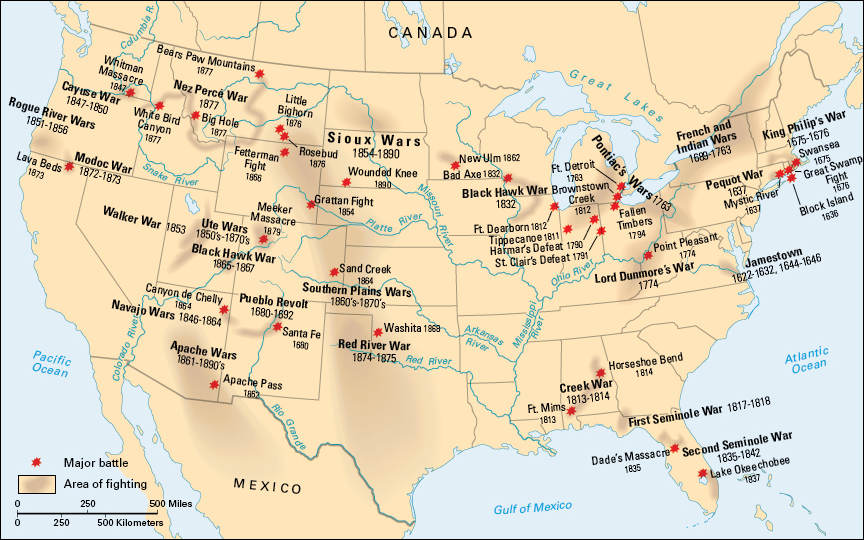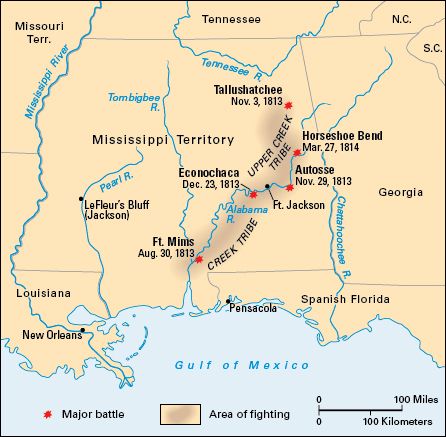Creek War began as a civil war among the Indigenous (native) Muscogee, or Creek people and developed into a United States war against the insurgent Creek faction known as the Red Sticks. The war largely took place in Upper Creek territory—now north and central Alabama—and the eastern part of the Mississippi Territory. The war ended in 1814 with the defeat of the Red Sticks at the Battle of Horseshoe Bend. Under the treaty that ended the war, the Creek gave up about two-thirds of their tribal homelands.
Background.
In the early 1800’s, a split developed among the Creek Nation. European traders had long used the name Creek to refer to allied tribes of the Muscogee (also spelled Muskogee) people. Many Creeks generally supported cooperation with U.S. officials, and they often adopted non-Indigenous customs. Tensions grew as European American settlers encroached on Muscogee lands. The American presence in the heart of the Creek country had also increased due to travel along a federal road that linked the coasts of the Atlantic Ocean and the Gulf of Mexico. A large number of Upper Creek were influenced by the Shawnee leader Tecumseh, who called for Indigenous peoples to unite and fight American expansion. They also resented the governing body known as the Creek National Council, which was dominated by elders who favored cooperation with the United States. Militant warriors who opposed cooperation became known as Red Sticks because of their traditional, red-painted war clubs.

Fort Mims.
In the summer of 1813, a group of Red Sticks under Peter McQueen, an Upper Creek chief, traveled to Pensacola, in what was then Spanish Florida. The group acquired ammunition from the Spanish government to use against the Creek National Council. During their return to the Mississippi Territory, territorial militia (civilian army) soldiers attacked the group. In response, Upper Creek headman William Weatherford planned an assault on Fort Mims, in what is now Baldwin County, Alabama.

On August 30, Weatherford, now popularly known as Red Eagle, led about 700 warriors against the fort. The group killed about 250 people and took dozens captive. News of the attack spread through the Southern frontier.
American offensive.
The attack on Fort Mims immediately changed the Creek civil war into an American war. Governments in Mississippi, Georgia, and Tennessee organized armed forces to support the Creek National Council and confront the Red Sticks. Federal troops and other Indigenous groups also joined the fighting. Major General Andrew Jackson, who would later become president, commanded a force of Tennessee militia. His force was supported by U.S. cavalry, Cherokee warriors, and some Creek allies.
In November, Jackson’s army routed a Creek force at the town of Tallushatchee (also spelled Tallussahatchee). Georgia militia, with help from allied Creek warriors, attacked and burned the Upper Creek town of Autosse (also spelled Atasi or Autossee). In December, Mississippi militia destroyed a Red Stick stronghold known as Econochaca or Holy Ground.
The Red Sticks lost most of the early battles of the Creek War. However, because most militiamen had enlisted for only short periods, American commanders had difficulty maintaining troop numbers.
Horseshoe Bend.
In early 1814, Jackson received a large number of reinforcements, including about 600 Regular Army troops. In March, he led a force of about 3,000 men to Tohopeka, the largest remaining Red Stick stronghold. The village stood near the tip of the peninsula at the Horseshoe Bend of the Tallapoosa River. About 1,000 Red Sticks, led by Chief Menawa, had barricaded the peninsula.
On March 27, Jackson’s troops bombarded Tohopeka with cannon fire. He launched a frontal assault after his Cherokee allies had created a diversion by attacking the Creeks from the rear. Most of the defenders were killed. The attacking force lost about 50 soldiers. Horseshoe Bend was the last major battle of the Creek War.
The end of the war.
The Creek War ended with the signing of the Treaty of Fort Jackson on Aug. 9, 1814. Under the treaty, the Creek gave up about 23 million acres (9.3 million hectares) to the United States. Much of this land had been controlled by the Lower Creek, who had provided support to the U.S. military effort.
After the war, many Creek joined the Seminole in Florida and Georgia. Jackson’s forces defeated these warriors in the First Seminole War (1817-1818). Alabama became a U.S. state in 1819.
